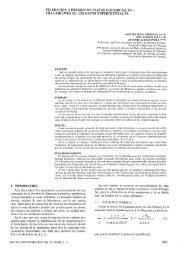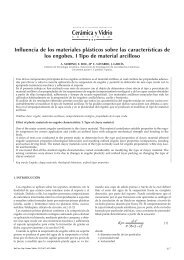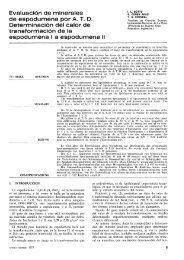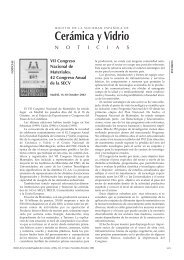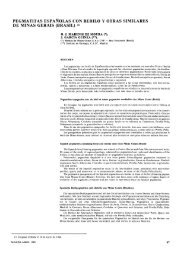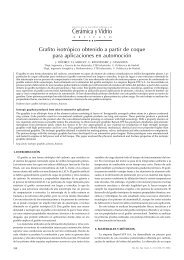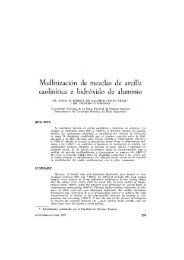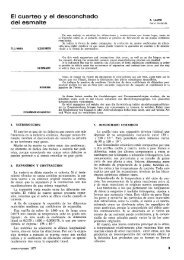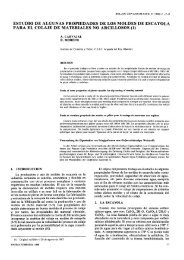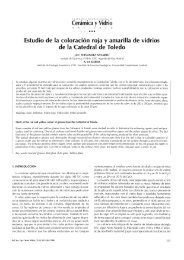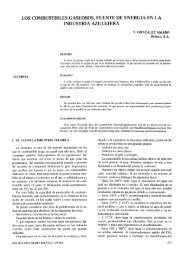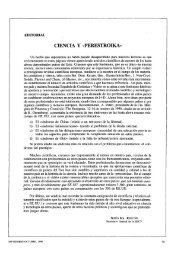Vidrios del sistema LÍ2O-SÍO2 preparados por la técnica sol-gel
Vidrios del sistema LÍ2O-SÍO2 preparados por la técnica sol-gel
Vidrios del sistema LÍ2O-SÍO2 preparados por la técnica sol-gel
You also want an ePaper? Increase the reach of your titles
YUMPU automatically turns print PDFs into web optimized ePapers that Google loves.
<strong>Vidrios</strong> <strong>del</strong> <strong>sistema</strong> <strong>LÍ2O</strong>-<strong>SÍO2</strong> <strong>preparados</strong> <strong>por</strong> <strong>la</strong> <strong>técnica</strong> <strong>sol</strong>-<strong>gel</strong><br />
obtenidas aquí. El hecho de que en los vidrios <strong>preparados</strong><br />
a partir de <strong>gel</strong>es <strong>la</strong> separación de fases se produzca a temperaturas<br />
menores que en los correspondientes vidrios <strong>preparados</strong><br />
<strong>por</strong> fusión convencional, ha sido atribuido (22, 37, 38)<br />
a <strong>la</strong> presencia de agua químicamente en<strong>la</strong>zada en los <strong>gel</strong>es<br />
así como a <strong>la</strong>s diferentes historias térmicas de ambos vidrios<br />
y a <strong>la</strong> existencia de una fina <strong>por</strong>osidad en los <strong>gel</strong>es que influye<br />
directamente en el mecanismo de nucleación.<br />
La figura Uc muestra <strong>la</strong> presencia de núcleos cristalinos<br />
en los <strong>gel</strong>es, y en <strong>la</strong> figura 12 puede observarse un cristal<br />
cuadrangu<strong>la</strong>r inmerso en una microestructura separada e interconectada.<br />
Debido a que el disilicato de litio aparece, en<br />
general, en forma de cristales esferolíticos, cabe atribuir al<br />
metasilicato de litio los cristales de <strong>la</strong>s figuras 11c y 12.<br />
4. CONCLUSIONES<br />
Se pueden preparar vidrios <strong>del</strong> <strong>sistema</strong> <strong>LÍ2O</strong>-<strong>SÍO2</strong> con<br />
hasta un 20% mo<strong>la</strong>r de <strong>LÍ2O</strong> <strong>por</strong> el procedimiento <strong>sol</strong>-<strong>gel</strong>,<br />
a temperaturas más bajas que <strong>la</strong>s requeridas para su obtención<br />
<strong>por</strong> <strong>técnica</strong>s usuales de fusión. Los vidrios <strong>preparados</strong><br />
desvitrifican <strong>por</strong> encima de 500 °C dando lugar a a-cuarzo<br />
y silicatos de litio, en pro<strong>por</strong>ciones variables según su composición.<br />
La evolución térmica de los <strong>gel</strong>es se lleva a cabo <strong>por</strong> una<br />
pérdida a bajas temperaturas <strong>del</strong> agua asorbida y <strong>por</strong> <strong>la</strong> condensación<br />
de los grupos si<strong>la</strong>noles, con eliminación <strong>del</strong> agua<br />
químicamente en<strong>la</strong>zada, a temperaturas superiores a 500°C.<br />
La concentración de iones Li^ en <strong>la</strong>s muestras no sólo determina<br />
<strong>la</strong> formación de redes de sflice más o menos abiertas<br />
o discontinuas, debido a <strong>la</strong> presencia de oxígenos no<br />
puente; sino que influye directamente en el modo de eliminación<br />
<strong>del</strong> agua y en el proceso de densificación. A mayores<br />
contenidos de <strong>LÍ2O</strong> el agua se pierde con mayor<br />
facilidad o a temperaturas algo menores.<br />
Los materiales <strong>preparados</strong> presentan una separación de fases<br />
parecida a <strong>la</strong> de los correspondientes vidrios <strong>preparados</strong><br />
<strong>por</strong> fusión, aunque el fenómeno en este caso se produce a<br />
temperaturas mucho menores (a partir de unos 500 °C), como<br />
consecuencia <strong>del</strong> elevado contenido de agua residual de<br />
los <strong>gel</strong>es que induce <strong>la</strong> inmiscibilidad.<br />
5. BIBLIOGRAFÍA<br />
1. GLASER, F. P.: Crystallization of lithium disilicate<br />
from <strong>LÍ2O</strong>-<strong>SÍO2</strong> g<strong>la</strong>sses. Phys. Chem. G<strong>la</strong>sses, 8<br />
(1967), 224-232.<br />
2. FREIMAN, S. W. y HENCH, L. L. : Kinetics of crystallization<br />
in <strong>LÍ2O</strong>-<strong>SÍO2</strong> g<strong>la</strong>sses. /. Am. Ceram. Soc, 51<br />
(1968), 382-387.<br />
3. JAMES, P. F.: Kinetics of crystal nucleation in lithium<br />
silicate g<strong>la</strong>sses. Phys. Chem. G<strong>la</strong>sses, 15 (1974),<br />
95-105.<br />
4. WoiGNiER, T., PHALIPPOU, J. y ZARZYCKI, J.: Evolution<br />
thermique des <strong>gel</strong>s d'alumino silicate alcalin. J.<br />
Phys. Coll. C9, sup. n°12, 43 (1982), 261-264.<br />
5. PHALIPPOU, J., PRASSAS, M. y ZARZYCKI, J.: Crystallization<br />
of <strong>gel</strong>s and g<strong>la</strong>sses made from hot-pressed <strong>gel</strong>s.<br />
/. Non-Cryst. Solids, 48 (1982) 17-30.<br />
6. VILLEGAS, M. A. y FERNÁNDEZ NAVARRO, J. M.: Alkaline<br />
silicate g<strong>la</strong>sses prepared via <strong>sol</strong>-<strong>gel</strong>. En Proc.<br />
1st Int. Workshop on Non-Cryst. Solids. SanFeliú. Ed.<br />
M. D. Baró y N. C<strong>la</strong>vaguera. World Scientific, Phi<strong>la</strong><strong>del</strong>phia<br />
(1986), págs. 433-440.<br />
7. ORCEL, G., PHALIPPOU, J. y HENCH, L. L.: Processing<br />
and structural evolution of (xLÍ20-(l-x)Na20)-<br />
•A1203-2SÍ02 <strong>gel</strong>s. /. Non-Cryst. Solids, 82 (1986),<br />
301-306.<br />
8. CoNGSHAN, Z., PHALIPPOU, y ZARZYCKI, J.: Influence<br />
of trace alkali ions on the crystallization behaviour<br />
of silica <strong>gel</strong>s. /. Non-Cryst. Solids, 82 (1986), 321-328.<br />
9. SCHWARTZ, I., ANDERSON, P., DELAMBILLY, H. y<br />
KLEIN, L. C: Stability of lithium silicate <strong>gel</strong>s. /. Non-<br />
Cryst. Solids., 83 (1986), 391-399.<br />
10. HAYRI, E. A. y GREENBLATT, M.: The preparation<br />
and ionic conductivity of <strong>sol</strong>-<strong>gel</strong>s in the <strong>LÍ2O</strong>-<br />
P2O3-<strong>SÍO2</strong> system. /. Non-Cryst. Solids, 94 (1987),<br />
387-401.<br />
11. BRANDA, F., ARONNE, A., MAROTTA, A. y BURI, A. :<br />
LÍ20-2SÍ02 <strong>sol</strong>-<strong>gel</strong> g<strong>la</strong>ss. /. Mat. Sei. Lett., 6 (1987),<br />
203-206.<br />
12. SAKKA, S.: G<strong>la</strong>sses and g<strong>la</strong>ss-ceramics from <strong>gel</strong>s. J.<br />
Non-Cryst. Solids, 73 (1985), 651-660.<br />
13. BOILOT, J. P. y C0LOMBAN, Ph.: Sodium and lithium<br />
superionic <strong>gel</strong>s and g<strong>la</strong>sses. /. Mat. Sei. Lett., 4 (1985),<br />
22-24.<br />
14. RAY AINE, D., SEMINEL, A., CHARBOUILLOT, Y. y<br />
ViNCENS, M.: A new family of organically modified<br />
silicates prepared from <strong>gel</strong>s. /. Non-Cryst. Solids, 82<br />
(1986), 210-219.<br />
15. VILLEGAS, M. A. y FERNÁNDEZ NAVARRO, J. M.: Caracterización<br />
de <strong>gel</strong>es 5R20-95SÍ02 mediante medidas<br />
de conductividad eléctrica y espectroscopia de infrarrojo<br />
próximo. Bol. Soc. Esp. Cerám. Vidr., 26 (1987),<br />
235-242.<br />
16. VILLEGAS, M. A., JURADO, J. R. y FERNÁNDEZ NA<br />
VARRO, J. M.: Dielectric properties of g<strong>la</strong>sses prepared<br />
via <strong>sol</strong>-<strong>gel</strong>. /. Mat. Sei. (Aceptado, en prensa.)<br />
17. KRACEK, F. C: Binary system <strong>LÍ2O</strong>-<strong>SÍO2</strong>. /. Phys.<br />
Chem., 34 (1930), 2.641-2.650.<br />
18. RINCÓN, J. M.: Estudio de nuevos vidrios y materiales<br />
vitrocristalinos <strong>del</strong> <strong>sistema</strong> LÍ20-CdO-Si02 con posible<br />
utilidad en <strong>la</strong> industria nuclear. Tesis doctoral,<br />
Madrid (1982). Págs. 27-30.<br />
19. VILLEGAS, M. A. y FERNÁNDEZ NAVARRO, J. M.:<br />
Preparación de vidrios de silicatos alcalinos <strong>por</strong> el método<br />
<strong>sol</strong>-<strong>gel</strong>. Bol. Soc. Esp. Cerám. Vidr., 26 (1987),<br />
99-108.<br />
20. AUSTIN, A. E.: X-ray diffraction data for compounds<br />
in systems <strong>LÍ2O</strong>-<strong>SÍO2</strong> and BaO-Si02. J. Am. Ceram.<br />
Soc, 30 (1947), 218-220.<br />
21. DECOTTIGNIES, M., PHALIPPOU, J. y ZARZYCKI, J.:<br />
Synthesis of g<strong>la</strong>sses by hot-pressing of <strong>gel</strong>s. /. Mat.<br />
Sei., 13 (1978), 2.605-2.618.<br />
22. VILLEGAS, M. A. y FERNÁNDEZ NAVARRO, J. M.:<br />
Characterizacion and study of Na20-B203-Si02 g<strong>la</strong>sses^<br />
prepared by the <strong>sol</strong>-<strong>gel</strong> method. J. Mat. ScL, 23 (1988),<br />
2.142-2.152.<br />
23. HAALAND, D. M. y BRINKER, C. J.: In situ FT-IR studies<br />
of oxide and oxynitride <strong>sol</strong>-<strong>gel</strong> derived thin films.<br />
Mat. Res. Soc. Symp. Proc, 32 (1984), 261-213.<br />
24. PRASAS, M. y HENCH, L. L.: Physical chemical factors<br />
in <strong>sol</strong>-<strong>gel</strong> processing. Processing of Ceramics,<br />
G<strong>la</strong>sses and Composites. Edit. J. Wiley and Sons, New<br />
York (1984). Págs. 100-125,<br />
MAYO-JUNIO, 1989 177



